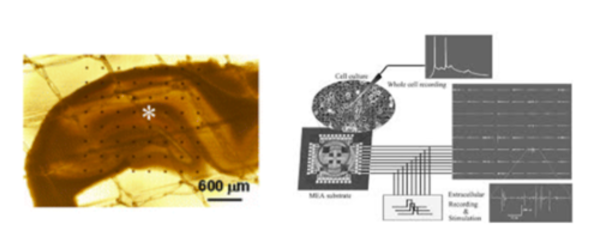Searching for quantum effects in neuroscience
Professors Michel Gingras and Zoya Leonenko from the Physics & Astronomy Department have recently started a new research effort in Quantum Neuroscience. With their colleagues Professors Michael Beazely (School of Pharmacy) and John Mielke (School of Public Health and Health Systems), they are combining their expertise in physics, biology and neuroscience with the ambitious goal to discover novel quantum effects in neuroscience, an exciting direction within the growing field of quantum biology.

Experiments involve measuring electrical activity in animal brain tissue: Typical example of a rat brain (hippocampal) slice deposited on an 8 x 8 multielectrode array (MEA) chip (dark black dots). One electrode (marked by an asterix) is used for the electrical stimulation of the tissue slice. The other 63 electrodes on a chip pick up the local electrical response distributed over the slice (so-called field excitatory postsynaptic potential, or f-EPSP), which allows to record electrical activity in a living tissue for up to 8 hours. Image taken from Zhao et al., Molecular Pain 5, 55 (2009); https://doi.org/10.1186/1744-8069-5-55.
The question whether quantum mechanics plays a singularly important role in biology has fascinated researchers for over a century. For example, in his remarkable and pivotal 1944 book “What is Life?”, Schrödinger had already raised captivating questions in regards to the relation of biology to quantum physics. In this context, a topical question is: does quantum mechanics merely dictate the principles of chemical bond formation and the structure of the myriad of molecules (e.g. proteins, lipids) found in biological systems, or do some of the most exotic phenomena of quantum mechanics, such as quantum tunneling, coherence and entanglement play critical roles in some essential processes of life? Examples where these may apply include light-harvesting in photosynthesis, olfaction (the sense of smell) and magneto-reception and its role in animal navigation and, most recently, in brain processes. Research and discoveries in quantum biology would not only provide new insights in the fields of biology and life sciences but also, by exposing that quantum mechanics is operational in hot and wet biology environments, inspire new ideas in the areas of quantum computing and quantum technologies.
What makes the human brain conscious? Why does our mood change? These are mysteries and questions whose answers will change the world. While the pursuit of these is at the forefront of many interdisciplinary international research efforts (e.g. Canadian Institute for Advanced Research’s Azrieli Program on Brain, Mind & Consciousness), a number of scientists, including renowned physicists, have mused at the question whether quantum effects could be involved in brain functions. Astonishingly enough, Sir Roger Penrose (2020 Physics Nobel Prize for his work on black holes) had ventured to speculate on the role of quantum gravity on consciousness, not without attracting harsh criticism. More recently, Matthew Fisher, a world renowned condensed matter theorist, has put forward a new and elaborate “Quantum Brain” proposal invoking entangled molecules affecting neuronal activity. At present, no direct experiment evidence for any of the quantum effects put forward by Penrose or Fisher has been directly exposed in living matter. However, a number of experimental results reported over the past thirty years find intriguing nuclear isotope effects in neurobiological settings that possibly suggest interesting quantum effects at play. At Waterloo, Beazely, Gingras, Leonenko and Mielke and their team of graduate and undergraduate students are now investigating some of those puzzling isotope results using a variety of experimental approaches. For example, the team is currently investigating whether there is a lithium isotope effect in neurobiological processes and is interested in studying the effect of Xe isotopes in the mechanism of anesthesia.
Lithium is an approved medication for the treatment of mood disorders, in particular bipolar disorder. Yet, despite thousands of papers over the past fifty years, the mechanism of its action is not well understood. Strikingly, earlier experiments in the mid 1980s reported dramatically different effects of lithium-6 and lithium-7 isotopes on animal behaviour. The Waterloo team is currently working to record electrical activity in animal brain tissues using a multi-electrode array in order to elucidate the effect of lithium isotopes on neuronal functions. They are also investigating the effect of the two lithium isotopes on biochemical reactions involved in neuronal signaling. This will help to clarify whether Li isotopes are influencing the fast electrochemical or slow biochemical signal processing in the brain.
With the goal of studying molecular processes in the brain, the Waterloo team is also looking at how general anesthetics work. The effect of general anesthetics on brain activity, specifically how they quench consciousness, presents another long-standing puzzle in the field of medicine and biology. Despite unabated and intense research spanning over a century, the molecular mechanisms via which general anesthetics operate remain incompletely understood. Interestingly, the inert gas xenon (Xe) is a highly potent general anesthetic. A recent 2018 paper reports results from an experiment in which a different anesthetic potency was found for the different isotopes of xenon – a remarkable result if correct and in need of verification.
The Waterloo team is now in the process of exploring these isotopes effects and recently acquired research finds from the Transformative Quantum Technologies – Quantum Quest Seed Grant at the University of Waterloo as well as a New Frontiers in Research Fund Exploration Grant that supports high-risk/high-reward research projects across Canada. In addition, the Waterloo Quantum Neuroscience team recently joined forces with a larger international “Quantum Brain” effort led by Matthew Fisher which combines five laboratories from three countries and that has recently acquired significant funding from a pharmaceutical company partner.
The exploration and possible unravelling of novel quantum effects in neuroscience is exciting and innovative and may provide ground-breaking contributions for the advancement of knowledge in Physics and Biology. Moreover, if quantum effects were indeed found to be present in biological systems, such research may provide new and important hints for the development of novel quantum computing technologies.
